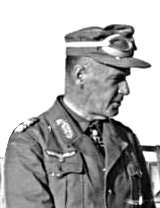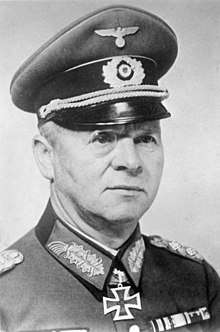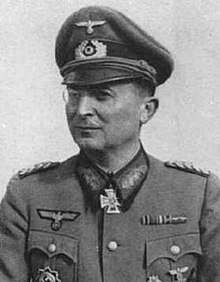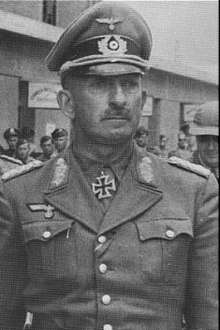Panzer Army Africa
As the number of German troops committed to the North African Campaign of World War II grew from the initial commitment of a small corps the Germans developed a more elaborate command structure and placed the enlarged Afrika Korps, with Italian units under this new German command and a succession of commands were created to manage Axis forces in Africa:
- Panzer Group Africa, (Panzergruppe Afrika, Gruppo Corazzato Africa) August 1941 – January 1942; German-Italian force
- Panzer Army Africa, (Panzerarmee Afrika, Armata Corazzata Africa) January–October 1942
- German-Italian Panzer Army, (Deutsch-Italienische Panzerarmee, Armata Corazzata Italo-Tedesca) October 1942 – February 1943
- Army Group Africa, (Heeresgruppe Afrika, Gruppo d'Armate Africa) February–May 1943
Panzer Group Africa
When the Afrika Korps was formed on 11 January 1941 it was subordinated to the Italian chain of command in Africa. In the middle of 1941 Oberkommando der Wehrmacht (OKW, Armed Forces High Command) created a larger command structure in Africa, forming a new headquarters, Panzer Group Africa (Panzergruppe Afrika, Gruppo Corazzato Africa). On 15 August 1941, Panzer Group Africa was activated with newly promoted General der Panzertruppe Erwin Rommel in command. The Panzer Group controlled the Afrika Korps and other units that were sent to Africa (notably the 90th Light Infantry Division), and the Italian X Corps and XX Corps.
Panzer Army Africa
Panzer Group Africa was renamed Panzer Army Africa (Panzerarmee Afrika, Armata Corazzata Africa) on 30 January 1942. (A German Panzer group was an army-level headquarters. As the war progressed all of the Panzer groups were renamed Panzer Armies.)
German-Italian Panzer Army
Panzer Army Africa was renamed German-Italian Panzer Army' (Deutsch-Italienische Panzerarmee, Armata Corazzata Italo-Tedesca) in October 1942 during the long retreat after the defeat at the Second Battle of El Alamein during the Western Desert Campaign.
Army Group Africa
In February 1943, the headquarters was expanded and called Army Group Africa (Heeresgruppe Afrika, Gruppo d'Armate Africa) to manage the defence of Tunisia during the final stages of the North African Campaign. Army Group Africa included the German Fifth Panzer Army (5. Panzerarmee) and the Italian 1st Army. Command of the Army Group was turned over from Rommel to Hans-Jürgen von Arnim in March. He surrendered the Army Group on 13 May 1943, ending the Axis presence in Africa.
Order of battle
Throughout its existence, this headquarters controlled the Afrika Korps and for most of its life it controlled a number of other German and Italian units as well. Not all German units in Africa subordinate to the Afrika Korps, some were reserves for the Panzer Army and some were occasionally subordinated to Italian armies or corps. The following overview of its components is taken from lexikon-der-wehrmacht de, with dates corrected (see references).
Orders of battle
Panzer Group Africa (Rommel)
- As of September 1941: (during Rommel's first push into the Western Desert)
- Afrika Korps
- X Corpo
- Corpo d'Armata di Manovra (Mobile Armoured Corps)
- 55th Infantry Division Savona
Panzer Army Africa (Rommel)
- As of January 1942: (during Rommel's second push into the Western Desert)
- Afrika Korps
- X Corpo
- XXI Corpo
- Corpo d'Armata di Manovra (Mobile Armoured Corps)
- 90th Leichte Afrika Division
- 55th Infantry Division Savona
- As of April 1942: (before and during the Gazala battles and the Siege of Tobruk)
- Afrika Korps
- X Corpo
- XX Corpo D'Armata di Manovra
- XXI Corpo
- German 90th Leichte Afrika Division
- As of August 1942: (in the lead up to the Battle of Alam el Halfa)
- Afrika Korps
- X Corpo
- XX Corpo D'Armata di Manovra
- XXI Corpo
- 133rd Armored Division Littorio
German-Italian Panzer Army (Rommel)
- As of November 1942: (during the withdrawal from the Western Desert)
- Afrika Korps
- X Corpo
- XX Corpo D'Armata di Manovra
- XXI Corpo
- German 90th Leichte Afrika Division
- 136th Infantry Division Giovani Fascisti
- 17th Infantry Division Pavia
- February 1943: (defending southern Tunisia)
- Afrika Korps
- XX Corpo D'Armata di Manovra
- XXI Corpo
- German 164th Leichte Afrika Division
- German Ramcke Parachute Brigade
Army Group Africa
From February 1943:
- German Fifth Panzer Army (5. Panzerarmee) (northern Tunisia)
- Italian 1st Army (southern Tunisia)
Commanders
| No. | Commander | Took office | Left office | Time in office | |
|---|---|---|---|---|---|
| 1 | Generaloberst Erwin Rommel (1891–1944) | 1 September 1941 | 9 March 1942 | 189 days | |
| 2 | General der Panzertruppe Ludwig Crüwell (1892–1958) | 9 March 1942 | 19 March 1942 | 10 days | |
| (1) | Generalfeldmarschall Erwin Rommel (1891–1944) | 19 March 1942 | 22 September 1942 | 187 days | |
| 3 | General der Panzertruppe Georg Stumme (1886–1942) | 22 September 1942 | 24 October 1942 † | 32 days | |
| - | Generalleutnant Wilhelm Ritter von Thoma (1891–1948) Acting | 24 October 1942 | 25 October 1942 | 1 day | |
| (1) | Generalfeldmarschall Erwin Rommel (1891–1944) | 25 October 1942 | 26 November 1942 | 32 days | |
| 4 | General der Panzertruppe Gustav Fehn (1892–1945) | 26 November 1942 | 2 December 1942 | 6 days | |
| (1) | Generalfeldmarschall Erwin Rommel (1891–1944) | 2 December 1942 | 22 February 1943 | 82 days | |
| 5 | Generaloberst Hans-Jürgen von Arnim (1889–1962) | 10 March 1943 | 13 May 1943 | 64 days |
.jpg)




